No products in the cart.
A Journey Through India’s Diverse Dussehra Celebrations
As autumn begins to sweep across India, the country gears up for one of its most celebrated festivals—Dussehra, also known as Vijayadashami. Marking the victory of good over evil, this grand festival takes on unique flavors across different regions, with each celebration offering a glimpse into local traditions and folklore.
Embarking on a journey through India’s Dussehra celebrations reveals the depth and variety of its cultural heritage, with places like Kullu, Mysore, and Bastar standing out for their distinct customs and festivities.
Kullu Dussehra (Himachal Pradesh)
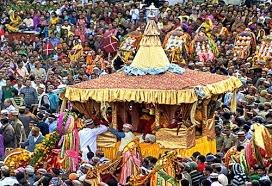
Tucked away in the stunning valley of Kullu, Himachal Pradesh, the town’s Dussehra celebration is unlike the effigy-burning ceremonies common in much of the country. The festival begins on the day of Dussehra and extends for seven days, with local deities from nearby villages carried in grand processions to the Dhalpur Maidan. The entire Kullu Valley becomes a stage for vibrant celebrations, featuring traditional Himachali music, colorful fairs, and a deep sense of devotion.
Legend has it that this unique tradition was started in the 17th century by King Jagat Singh, who installed an idol of Lord Raghunath (Lord Rama) as the ruling deity of the Kullu kingdom. Today, the highlight of Kullu Dussehra is the assembly of hundreds of deities from neighboring villages, all converging to pay their respects to Lord Raghunath, symbolizing unity and cultural harmony.
Mysore Dasara (Karnataka)
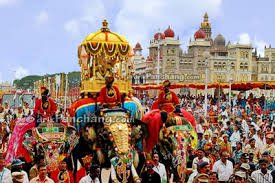
In the royal city of Mysore, Dussehra is celebrated with regal grandeur, harking back to its royal legacy. Known as “Nada Habba” (state festival) in Karnataka, the Mysore Dasara is a ten-day festival that dates back to the Wodeyar dynasty, with festivities focused around the magnificent Mysore Palace. The city is bathed in dazzling lights, and grand processions of elephants, horses, and decorated chariots take place through the streets.
The centerpiece of Mysore Dasara is the grand procession on Vijayadashami, with an idol of Goddess Chamundeshwari placed on a golden howdah atop a caparisoned elephant. This ceremonial march through the heart of the city is accompanied by folk performances, music, and a spirit of celebration that reflects the grandeur of Karnataka’s cultural traditions.
Bastar Dussehra (Chhattisgarh)
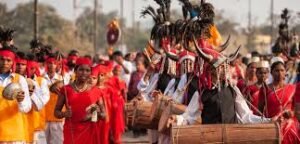
Moving to the heart of India, Bastar in Chhattisgarh presents one of the longest and most fascinating Dussehra celebrations, stretching over 75 days. Unlike the rest of the country, Bastar Dussehra does not focus on Lord Rama’s victory over Ravana but instead celebrates the local deity Danteshwari, who is revered as the protector of the region.
The festival is an eclectic mix of tribal customs, processions, and sacrifices. The local indigenous communities, including the Gond, Maria, and Muria tribes, actively participate, showcasing their distinct traditions through rituals, music, and dance. One of the most striking elements of Bastar Dussehra is the “Kachan Gadi” ritual, in which a young girl is enthroned as a symbol of purity and prosperity, adding a unique dimension to the celebration.
Varanasi Dussehra (Uttar Pradesh)

Varanasi, one of the holiest cities in India, offers a spiritual and theatrical take on Dussehra. The city’s famed Ramnagar Ramlila is an integral part of its Dussehra celebrations. This Ramlila, a dramatic enactment of the Ramayana, takes place over several weeks, leading up to Dussehra.
What sets Varanasi apart is the immersive and detailed portrayal of the Ramayana, with local actors performing against the backdrop of the historic Ramnagar Fort. Audiences travel from one location to another within the town, following the actors as they recreate key scenes from the epic. On the day of Dussehra, the final battle between Lord Rama and Ravana is enacted, culminating in the symbolic burning of Ravana’s effigies along the banks of the Ganges.
Kota Dussehra (Rajasthan)
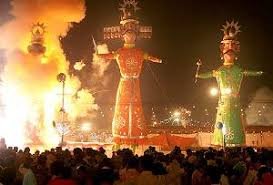
In Rajasthan’s Kota, Dussehra is celebrated with a royal touch that mirrors the desert state’s grandeur. The Kota Dussehra Mela is known for its gigantic effigies of Ravana, Meghnad, and Kumbhakarna, which are burned in front of large crowds. However, the celebration goes beyond effigy burning, featuring a vibrant fair that attracts visitors from across the region.
The festival includes folk performances, camel rides, exhibitions of local handicrafts, and an electric atmosphere that showcases Rajasthan’s cultural richness. Kota’s royal family also plays an important role in the proceedings, with traditional customs and rituals lending the celebration a sense of regal splendor.
Delhi Dussehra (National Capital)
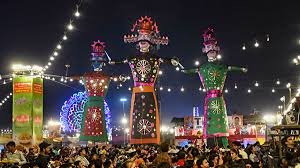
In the national capital, Delhi’s Dussehra combines tradition with the grandeur of modern-day celebrations. The city hosts numerous Ramlilas, with the most prominent being at the Red Fort grounds, where thousands gather to watch the final act of Lord Rama’s victory over Ravana. The event is marked by the spectacular burning of Ravana’s towering effigies, often accompanied by fireworks that light up the night sky.
Delhi’s Dussehra celebrations are known for their festive energy, with streets lined with food stalls, fairground rides, and cultural performances. Despite being a bustling metropolis, Delhi manages to keep alive the traditions of Dussehra while giving them a modern twist.
From the snowy valleys of Kullu to the royal courts of Mysore, and the tribal heartlands of Bastar to the spiritual alleys of Varanasi, Dussehra in India is a tapestry of diverse customs and traditions. Each region brings its unique flair to this ancient festival, making it not just a celebration of good over evil but also a celebration of India’s incredible cultural diversity. Whether you are drawn to the opulence of Mysore or the earthy rituals of Bastar, Dussehra offers something for every traveler looking to experience India’s festive spirit.
















